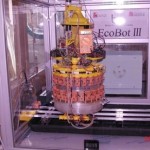
Every machine that runs on a battery need to recharge, be it from an electric shaver to ipod. Do we have a way to make this go away. Well, I cant assure for every machine but surely the future robot generation will be free from this hassle.
Tomorrow’s new generation of self-sustaining robots might keep going nearly forever by grazing on dead insects, rotting plant matter or even human waste.
The vision of robots capable of plugging themselves into the natural world of living organisms has begun taking shape in several labs around the world, and even NASA has shown renewed interest in powering space robots with microbes. But one British lab has already been building on the work of robotics pioneers to create small “EcoBots” that extract energy from microbial fuel cells since 2002.
The first EcoBot (created in 2003) was powered by E. coli bacteria feeding on refined sugar. Then “EcoBot-II” (2005) harnessed sludge microbes to break down dead flies, prawn shells and rotten apples. Finally, “EcoBot-III” (2010) showed how a “digesting” robot could also dump its leftover waste, so that its microbes wouldn’t be poisoned by their own filth and could keep powering the robot.
“EcoBot-III is a robot that collects its own food and water from the environment,” said Ioannis Ieropoulos, a roboticist at the Bristol Robotics Laboratory (BRL). “It performs the task we design it to do, and at the end of the day, it gets rid of its own waste. It literally craps into its own ‘litter’ tray.”
Ieropoulos, Greenman and BRL Director Chris Melhuish, give credit to other researchers for first showing how robots could use bacteria, and for pioneering the development of microbial fuel cells powered by sludge. But they have pushed the field forward by making robots capable of performing tasks — such as maintaining a circulatory system and wirelessly reporting on their environment while moving toward food, water or light — when solely powered by microbial fuel cells (MFCs) to digest organic matter and dump any waste.
The EcoBot team’s work with such technology has not gone unnoticed. They received funding from the Bill & Melinda Gates Foundation in late 2011 so that they could push the limits of stacking microbial fuel cells that help tackle sanitation and energy needs by turning human urine or waste into useful electricity for radios or other gadgets.
For now, the robots remain limited by the power available in microbial fuel cells so that they must sit still and charge their batteries before doing activities in short bursts. But the EcoBot team hopes that each new robot can both shrink in size and have more available power based on boosting the stacks of microbial fuel cells — a goal for EcoBot-IV.
High hjh